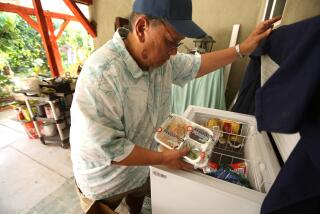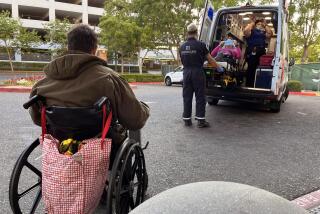Northridge Hyperbaric Program to Shut Down
- Share via
NORTHRIDGE — Mike Potter was scared and in tears after learning that an infection in his left toe might cost him his leg. So he went to the hyperbaric medicine department at Northridge Hospital Medical Center for a second opinion.
A doctor told Potter, a diabetic, that his ruptured toe blister could be treated with a combination of antibiotics and the hyperbaric chamber, which suffuses non-healing wounds with concentrated oxygen. Potter’s toe was eventually amputated, but the infection, a common ailment among diabetics, was halted and his leg was saved.
“I wouldn’t be walking around if it wasn’t for the hyperbaric chamber,” said Potter, a 56-year-old retired airline pilot who lives in Mojave. “I can’t tell you the number of people they have saved.”
But the Northridge hospital’s hyperbaric medicine department will stop saving life and limb after today. The 15-year-old program, which has treated about 3,000 patients and was once the largest in the Western U.S., will shut down because Medicare has cut reimbursements for hyperbaric outpatients, hospital officials said.
Medicare is switching from a “cost-based” approach for outpatient payments, which is more open-ended, to paying fixed rates for services, federal officials said.
“This was a better way to pay for the services,” said Dr. Laurie Feinberg, a medical officer with the federal Health Care Financing Administration, which oversees Medicare. “This was to create proper incentives for efficiency.”
Starting Tuesday, Medicare will pay hospitals about $320 for every two-hour hyperbaric chamber treatment, representing a 33% cut in current rates, hyperbaric medicine experts said.
It costs Northridge Hospital Medical Center about $800 to deliver one treatment, said spokeswoman Andrea Bogdan, adding that the hospital cannot maintain the service even by reducing hours and staff.
“We can’t afford that kind of loss. No hospital can,” Bogdan said. “There’s no way to reduce costs without compromising patient care and patient safety.”
Although Medicare cuts will hurt, industry experts and former Northridge staff members say the hospital decided to close the program as part of a wide range of cost-cutting measures that could affect other services.
Program Reached Beyond Valley
Northridge was purchased in 1998 by Catholic Healthcare West of Southern California, a nonprofit company that owns 13 hospitals, three in the Valley.
Last year, Northridge cut about 100 jobs at its Roscoe Boulevard campus, site of the hyperbaric program, after posting major losses.
Dr. John Alexander, who started the Northridge hyperbaric program and ran it until last December, said he retired because he was not receiving support from administrators. For example, he said, the hospital was not advertising the program.
“It’s a tragedy,” said Alexander, who now lives in Washington state. “It’s certainly a community resource that’s gone. The community they served was larger than Northridge and went beyond L.A. County.”
When the hyperbaric program opened at Northridge, patients came from as far as Arizona, Alexander said. It was the only Los Angeles area chamber that treated critically ill patients, he said, and often other hospital hyperbaric programs called Northridge’s experienced staff for advice. The program has treated all kinds of patients--people with carbon monoxide poisoning, flesh-eating bacteria, gangrene, severe burns, chronic infections and “the bends,” a possibly fatal condition suffered by deep-sea divers who surface too quickly.
In the chamber, patients inhale oxygen in a pressurized environment for about two hours, during which the oxygen level in a patient’s bloodstream is raised dramatically, increasing the capacity of blood cells to fight disease. It also helps body tissue heal faster. The treatment was first used against diseases in the late 1950s.
Northridge is one of only a few hospitals in the state with multiplace chambers that can hold about a dozen patients during a treatment. Four Valley hospitals have several smaller, less-expensive monoplace chambers that hold one patient at a time. After Northridge closes, UCLA Medical Center will have the only multiplace chamber in Los Angeles County.
Rob Ord, director of UCLA’s Gonda Center for Wound Healing and Hyperbaric Medicine, expects many Northridge patients to travel to Westwood.
“Many who had multiplace chambers won’t want it any other way,” he said, adding that some patients get claustrophobic in the smaller chambers. “This is a medicine that’s not going to go away, and Medicare realizes that.”
Aurora Rios said she has not decided where she will take her husband, Pedro, a diabetic who suffers from skin ulcers.
“If he has another ulcer, I don’t know what’s going to happen,” said Aurora Rios, 57, of Pacoima. “At Northridge, he found relief.”
Closure Will Affect the Needy
Aurora Rios does not drive and a transportation company takes her and Pedro, whose legs were amputated because of diabetes, to Northridge Hospital. Pedro Rios, 63, said he enjoys sitting in the large hyperbaric chamber, chatting with patients and staff members.
“It alleviates you all over,” he said. “It improved one of my hands a lot.”
Dr. Tom Millington, medical director of the wound treatment and hyperbaric department at St. John’s Pleasant Valley Hospital in Camarillo, said he fears the Northridge closure will have far-reaching repercussions for the most vulnerable--the poor, elderly and diabetics, especially those who have lost limbs or vision and cannot drive.
“People will end up losing limbs that could be saved if they could go to a hyperbaric program,” he said. “As usual, government affects the elderly, the disabled, who can least afford cutbacks in their care. Next thing you know, we’ll have medicine like how it was in the 1930s.”
Two weeks ago, Valley Presbyterian Hospital in Van Nuys opened a wound care center with two monoplace chambers. Mike Comer, the center’s program director, said Medicare cuts will have less impact because the hospital’s smaller chambers are less expensive to maintain and require less staff than the multiplace type.
“We were really concerned about the lack of comprehensive wound care in the area,” Comer said.
About 20% of patients who suffer from non-healing wounds benefit from hyperbaric chamber therapy, experts said. Patients in this group may create increased medical costs for Medicare if they are forced to undergo amputations instead of hyperbaric chamber treatment, Millington said. Surgery, prosthesis and rehabilitation cost thousands of dollars more than successful hyperbaric therapy, he said.
Nationwide, up to 60,000 diabetics undergo amputations every year.
More to Read
Sign up for Essential California
The most important California stories and recommendations in your inbox every morning.
You may occasionally receive promotional content from the Los Angeles Times.













